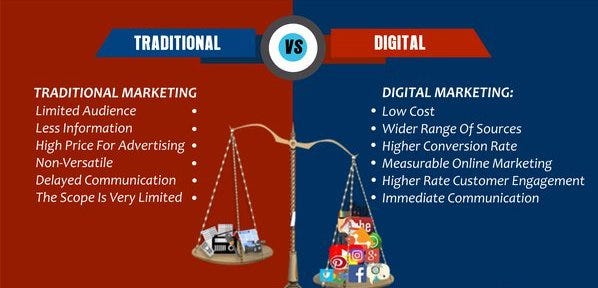
Is Traditional Marketing Dead? For decades, the landscape of marketing was dominated by billboards, TV commercials, and magazine spreads. These traditional methods, while effective in their time, now face a formidable challenge: the digital revolution. With consumers glued to their screens and bombarded with targeted ads, has traditional marketing lost its bite? The answer, it turns out, is more nuanced than a simple yes or no.
Is Traditional Marketing Dead? The Rise of the Digital Natives:
The generation born after the internet’s boom, Generation Z, has fundamentally reshaped the way we consume information and interact with brands. They crave authenticity, transparency, and experiences over flashy sales pitches. They’re adept at ad-blocking and have a keen radar for inauthenticity. This has led to a decline in the effectiveness of traditional methods that rely on passive consumption and one-way communication.
Is Traditional Marketing Dead? The Power of the “Anti-Campaign”:
Enter the “anti-campaign,” a new breed of marketing that rejects the traditional playbook. Instead of bombarding customers with messages, it focuses on building genuine connections and fostering brand loyalty through subtle, often subversive means. Here are some key characteristics of the anti-campaign:
- Transparency and authenticity: Anti-campaigns prioritize honesty and vulnerability over polished perfection. They showcase the “real” side of the brand, acknowledging its flaws and imperfections. This resonates with Gen Z’s desire for relatable and down-to-earth experiences.
- Focus on values and purpose: Rather than simply selling products, anti-campaigns highlight the brand’s values and social impact. They connect with consumers on an emotional level by aligning with causes they care about.
- Experiential engagement: Anti-campaigns go beyond static ads and create interactive experiences that allow consumers to participate and co-create. This fosters a sense of community and belonging, turning customers into brand advocates.
- Embracing alternative channels: While not completely abandoning traditional media, anti-campaigns leverage social media, influencer marketing, and user-generated content to reach their target audience more directly. This allows for hyper-targeting and personalized messaging.
Is Traditional Marketing Dead? Examples of Successful Anti-Campaigns:

- Patagonia’s “Don’t Buy This Jacket” campaign: This controversial campaign encouraged consumers to only buy new Patagonia products if they absolutely needed them, promoting sustainability and responsible consumption.
- Dove’s “Real Beauty” campaign: Dove challenged traditional beauty standards by featuring diverse models with different body types and ethnicities. This resonated with women who felt excluded by the unrealistic portrayals in mainstream media.
- Airbnb’s “Live There” campaign: Airbnb shifted focus from simply promoting rentals to showcasing the unique experiences and cultural immersion offered by staying in local homes. This resonated with travelers seeking authentic connections and adventures.
Is Traditional Marketing Dead? The Verdict: Coexistence, Not Extinction:
So, is traditional marketing dead? Not entirely. While its dominance has waned, it can still be a valuable tool when used strategically. The key is to integrate traditional methods with modern digital approaches and embrace the spirit of the anti-campaign. Focus on building genuine connections, highlighting social purpose, and creating engaging experiences.
Traditional marketing can still be effective in reaching older generations or building brand awareness through mass media channels. However, it needs to be supplemented with targeted digital campaigns that cater to the specific needs and preferences of Gen Z and beyond.
The future of marketing lies in a hybrid approach that leverages the best of both worlds. Traditional methods can provide reach and brand recognition, while digital tools can offer personalization, engagement, and real-time measurement. Ultimately, it’s about understanding your audience, embracing authenticity, and creating meaningful experiences that resonate with consumers on a deeper level.
The Rise of the Anti-Campaign is not a death knell for traditional marketing, but rather an evolution. It’s a call to reimagine how we connect with consumers in a world where authenticity and engagement are paramount. By embracing the principles of the anti-campaign, brands can build lasting relationships with their customers and thrive in the ever-changing digital landscape.
Is Traditional Marketing Dead? Embracing the New Rules of Engagement:

While the principles of the anti-campaign offer a valuable roadmap for future marketing, successfully navigating this shift requires more than just embracing authenticity and purpose. Here are some key strategies to consider:
1. Data-driven personalization:
Gone are the days of one-size-fits-all advertising. Consumers crave tailored experiences that cater to their individual needs and preferences. Leveraging data analytics and AI-powered targeting allows brands to deliver highly relevant messages and content across multiple channels.
2. Content is king (and queen):
High-quality content that provides value and sparks genuine interest is essential for engagement in the digital age. This could include informative blog posts, captivating videos, interactive quizzes, or user-generated content that promotes authenticity and community.
3. The power of micro-influencers:
Gone are the days of relying solely on celebrity endorsements. Today, consumers trust the recommendations of relatable individuals with smaller, but more engaged followings. Partnering with micro-influencers who align with your brand values can tap into niche audiences and build trust through authentic storytelling.
4. Building communities, not just customers:
Creating a sense of belonging and fostering genuine connections is crucial for fostering brand loyalty. Interactive online communities, loyalty programs, and offline events can provide opportunities for customers to connect with each other and the brand, building a lasting relationship that transcends mere transactions.
5. Embracing social responsibility:
Consumers are increasingly concerned about the social and environmental impact of the brands they support. Aligning with causes that resonate with your target audience and demonstrating active commitment to sustainability can earn brand trust and loyalty.
The Path Forward:
The rise of the anti-campaign is not just a marketing trend; it’s a cultural shift. Consumers are demanding more than just products and services; they crave authenticity, experiences, and brands that share their values. By embracing the principles of transparency, purpose, and engagement, brands can navigate this new landscape and build lasting relationships with their customers.
Is Traditional Marketing Dead? Traditional marketing is not dead, but it needs to evolve. By incorporating the lessons of the anti-campaign and continuously adapting to the changing preferences of consumers, brands can thrive in the digital age and build a future where marketing is not just about selling, but about creating meaningful connections that leave a lasting positive impact.
Remember, this is just the beginning of the conversation. As technology and consumer behavior continue to evolve, the future of marketing remains dynamic and exciting. The brands that stay ahead of the curve, embrace the spirit of the anti-campaign, and prioritize genuine engagement will be the ones that truly connect with their audience and ultimately succeed.
